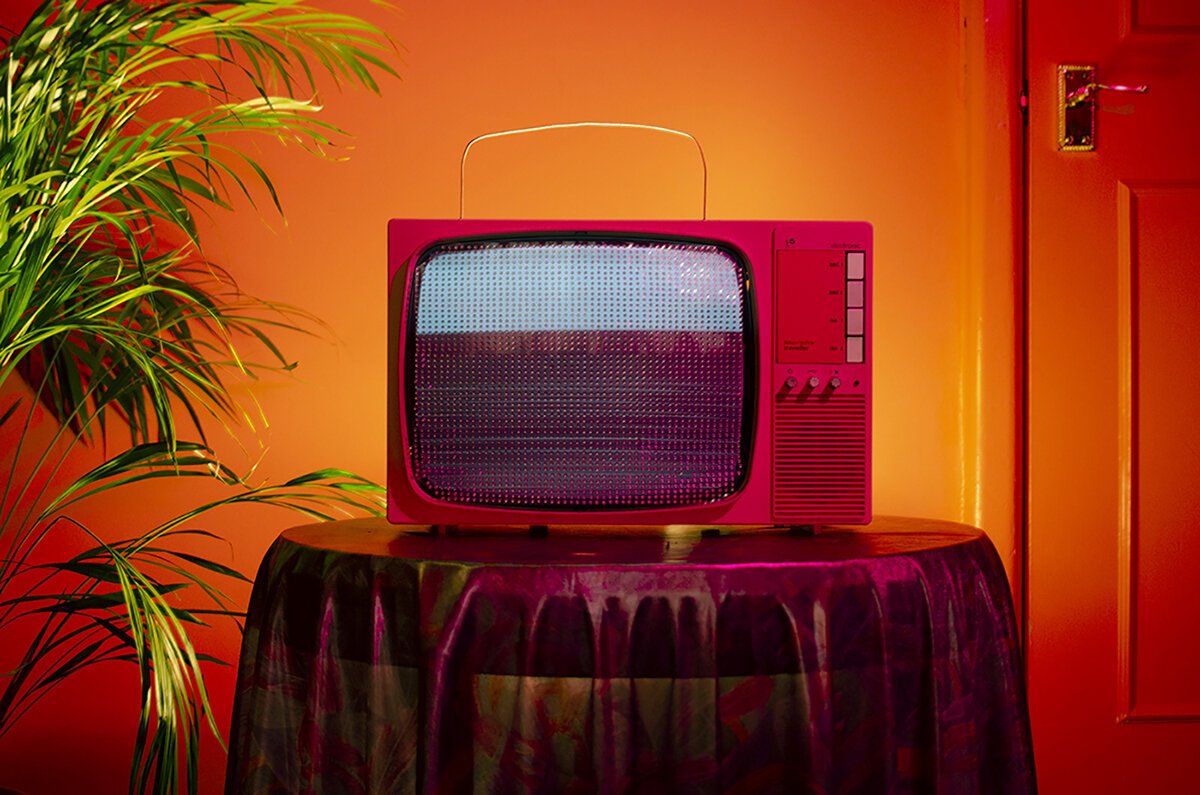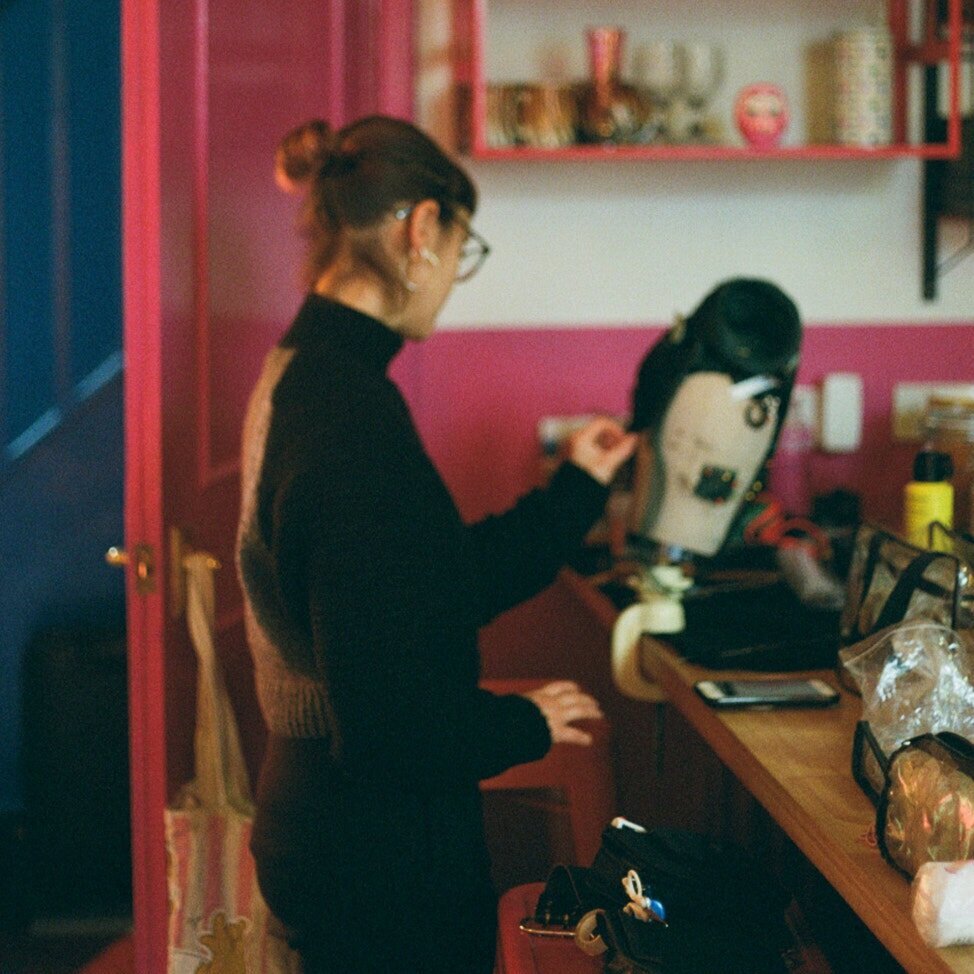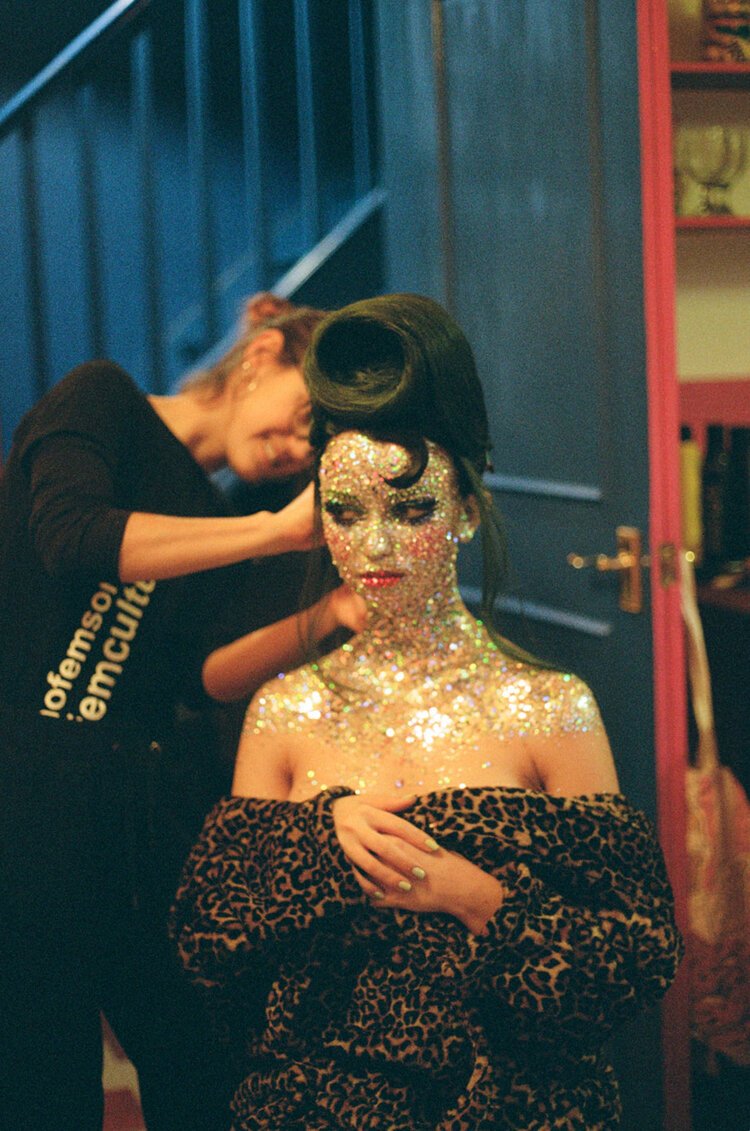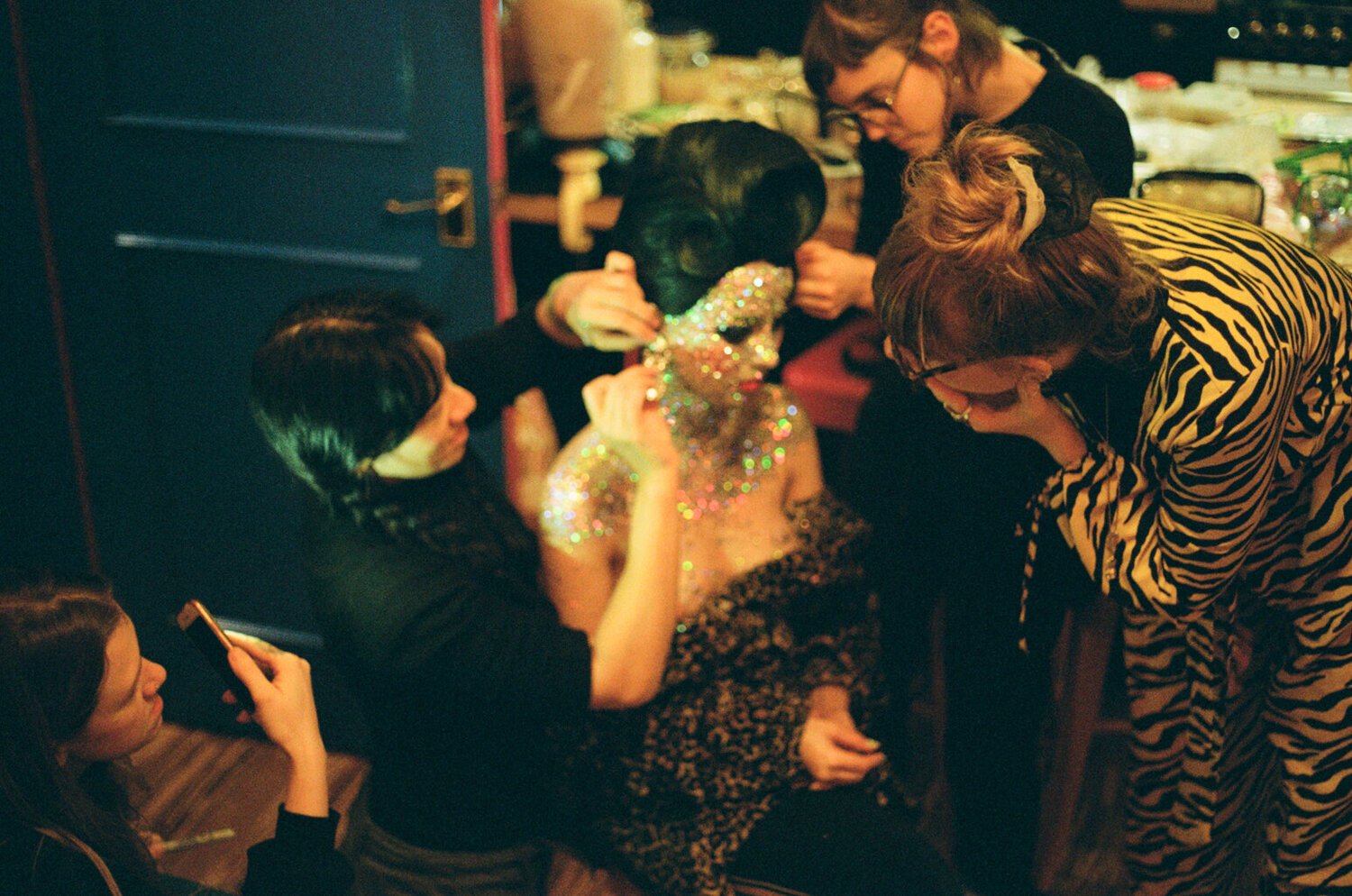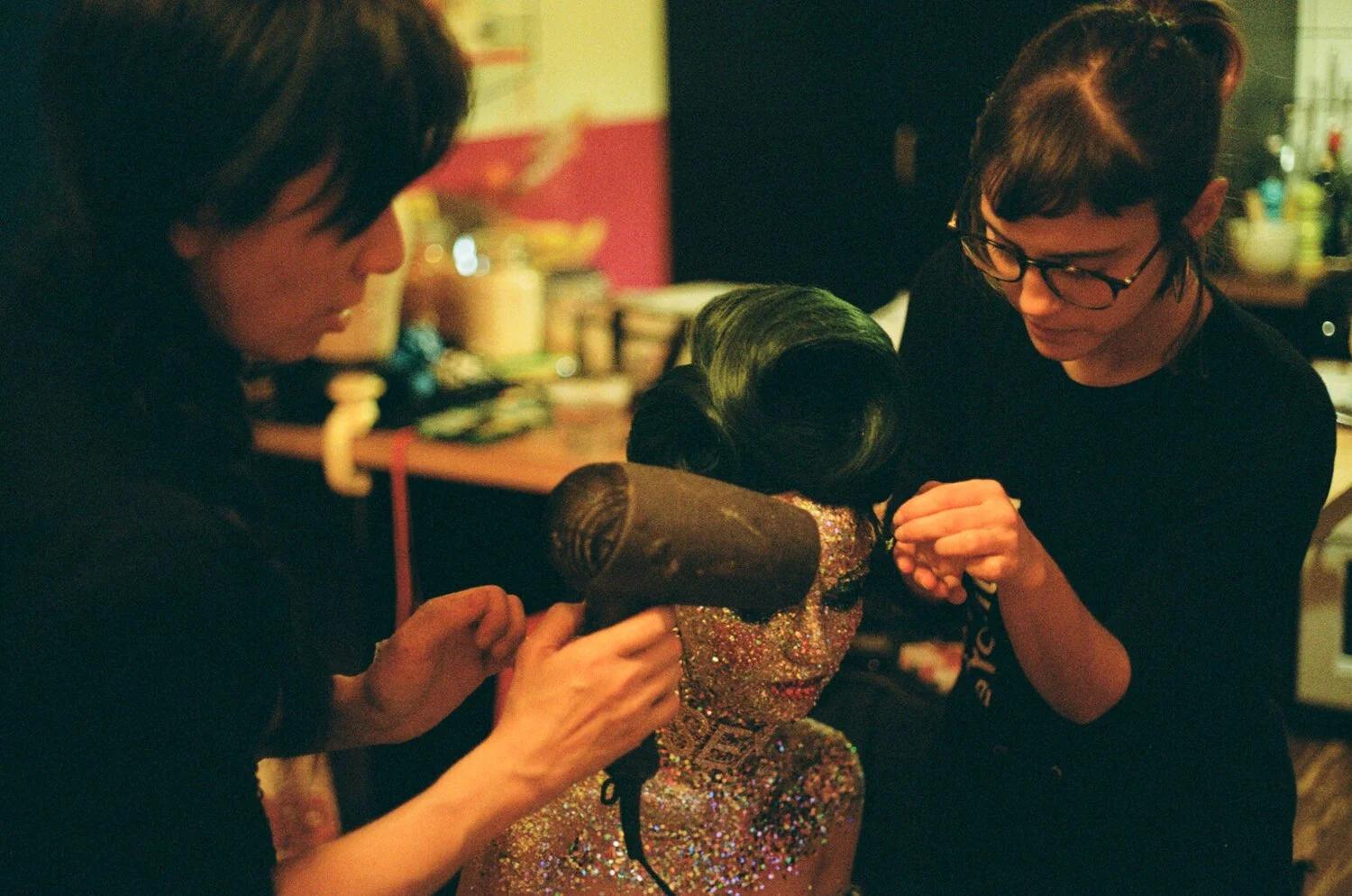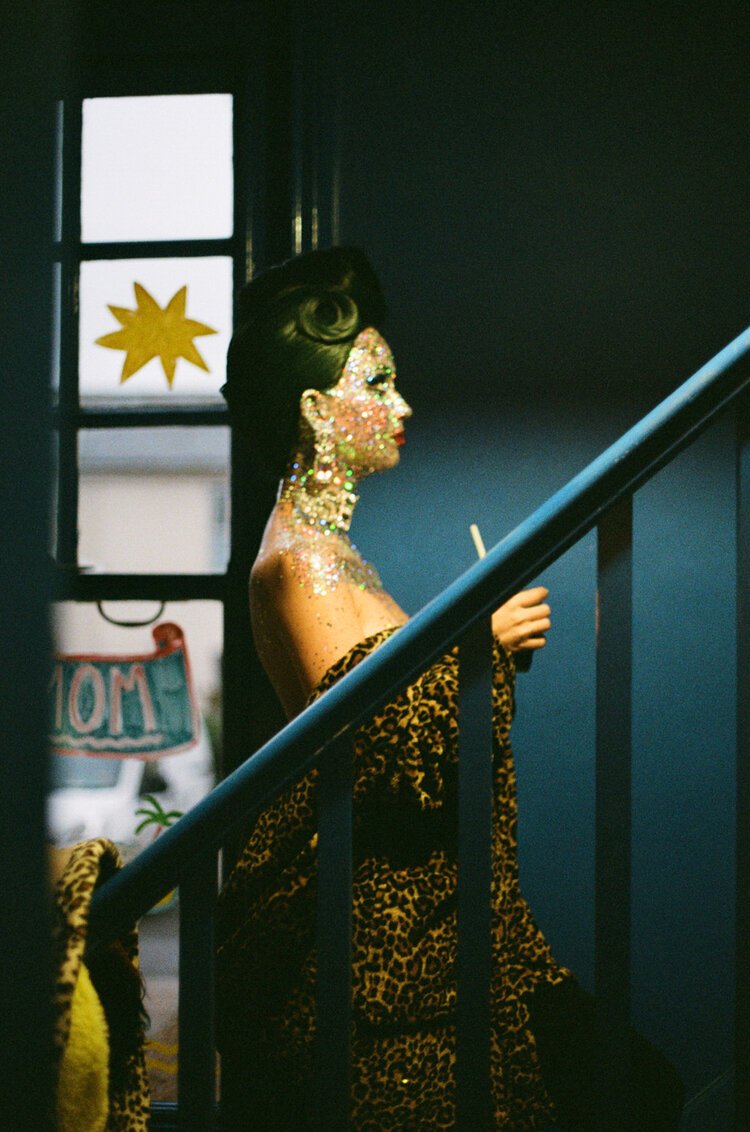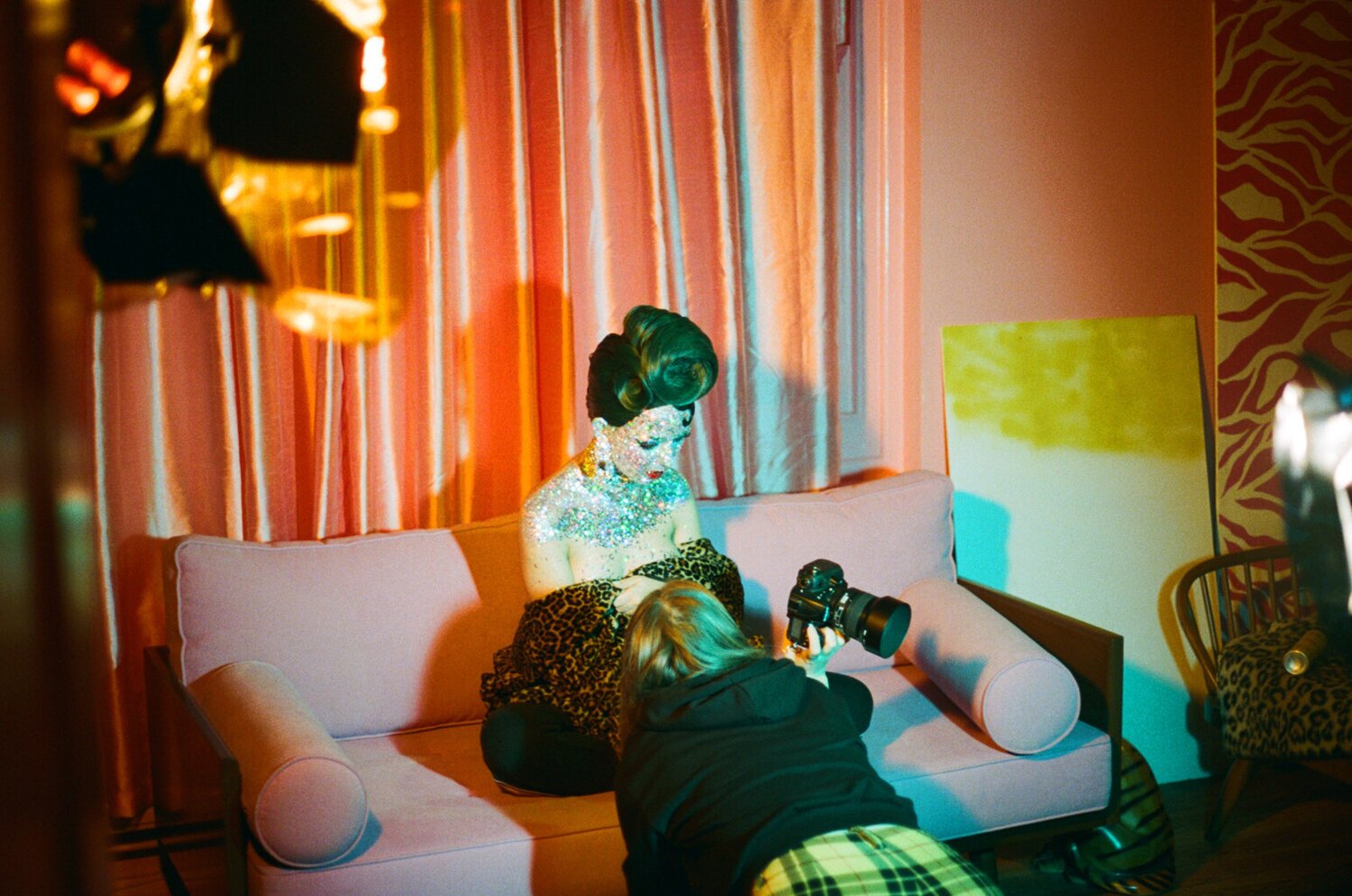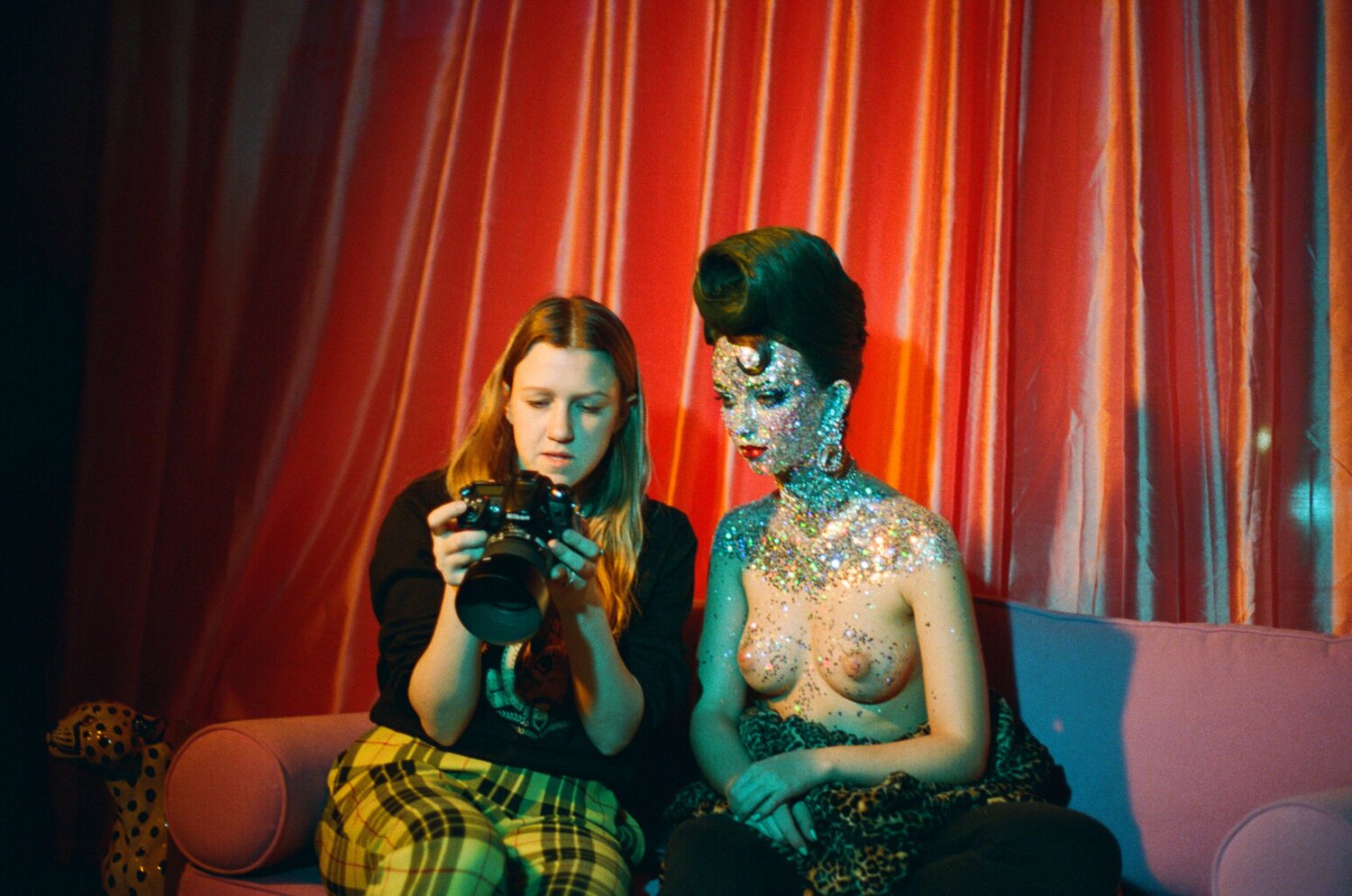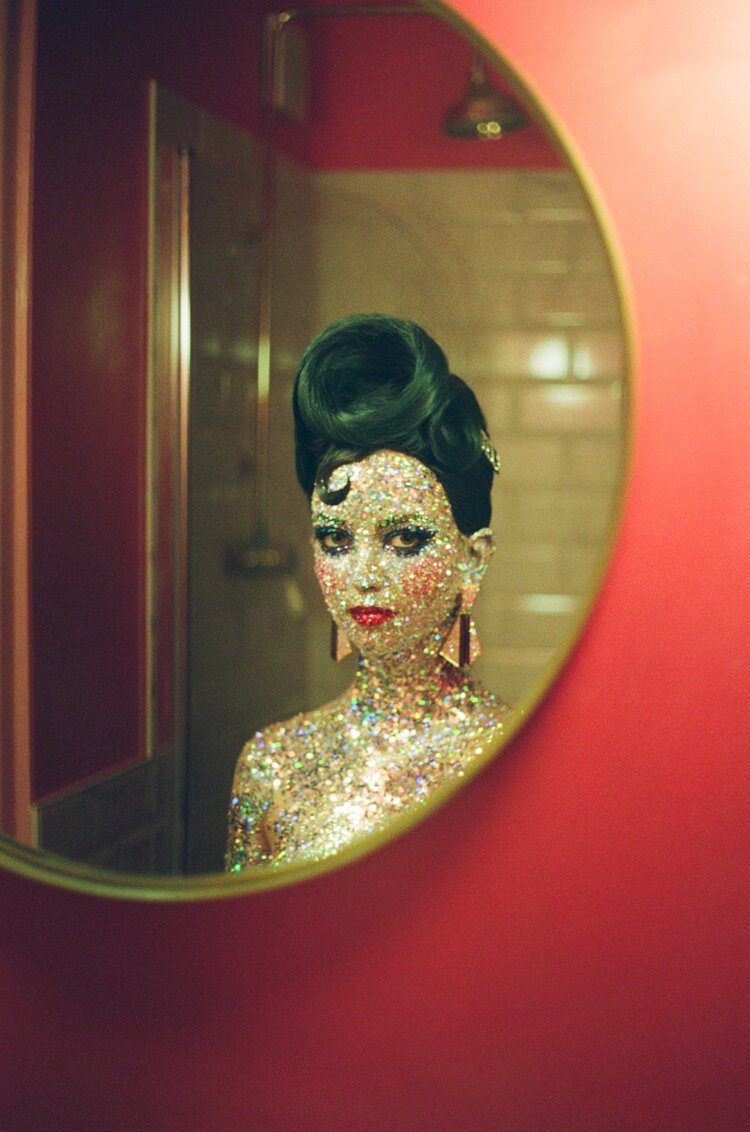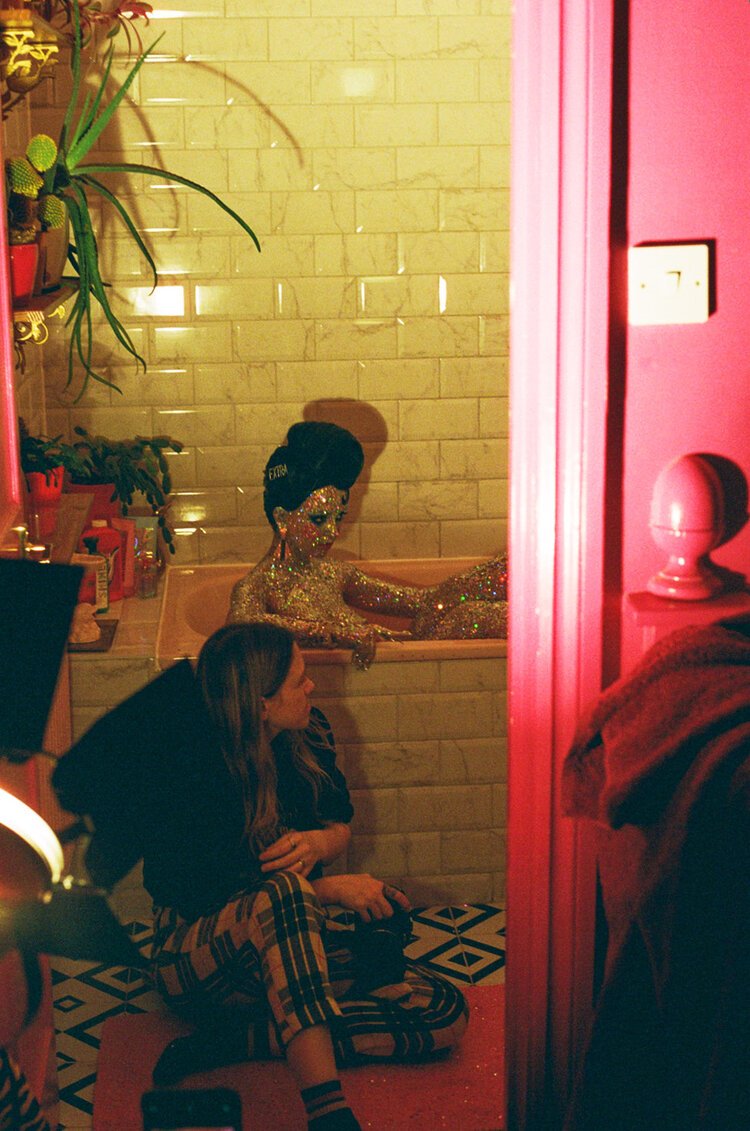Jasmine De Silva: Behind the Crystal Woman
July 18th, 2020
By Grace Proctor @grace_proctor_
Combining retrofuturism, hyperreal aesthetics, pop-art style colours and diamond studded female bodies, Jasmine De Silva playfully satirises the desire for physical perfection in her striking film and photo series, Crystal Clean. Join us as we speak to the award-winning artist about collaboration, unrealistic beauty ideals and future projects, and deep-dive into the world of the Crystal Woman, meeting the collaborators who bought her to life.
Watching Jasmine De Silva’s Crystal Clean, you find an ‘indulgent home video’ of a woman trapped in diamante skin and her desire for aesthetic perfection. Otherworldly, floating, expressionless and timeless, Crystal Clean resists the transparency of its title. With retro aesthetics, looping music and dazzling lighting, we are charmed into a claustrophobic suburban world where opulence meets the mundane, and the need for glamour is etched onto the skin. Here The Crystal Woman is a glittering medusa, warning us that staring at your reflection can and will turn you to stone, as De Silva holds a mirror up to our own dehumanising obsession with appearances. Deftly exposing the dangers of society’s unrealistic standards of beauty.
A huge fan of the project, I sat dawn with Jasmine (all-be-it digitally, since at the time London was under strict lock-down), to find out more:
POL: Your most recent project is titled Crystal Clean, can you introduce us to the project and it’s inspiration?
JDS: The idea for Crystal Clean popped into my head last summer, where I imagined a crystal covered woman just chilling on her sofa on a Friday night, with the idea in mind that we feel like we have to be dressed for every occasion, even if it’s as mundane as watching Netflix.
This progressed into thinking of a woman going about more of these everyday activities within various rooms of her home, making an indulgent home video. The crystal covering is supposed to feel a bit uncomfortable, to represent that feeling of entrapping ourselves inside the need to be so perfect, that we could barely move. I imagined her using this product called Crystal Clean as though it’s a beauty and cleaning product all in one.
“What I love about fashion photography is the story-telling, the fashion element comes last.”
POL: Let’s talk about creating the Crystal Woman, she is so intricate! Could you tell us a bit about her design and makeup/costume? Who did you work with to create her?
JDS: I couldn’t have asked for anyone better to create this makeup for the Crystal Woman. Natasha Lawes is an incredible artist, and this was actually the first time we’ve worked together. Prior to the shoot we discussed the fear of it turning into a strange festival look which, we really wanted to avoid, as the aim was to still have human attributes - for it to feel totally normal in this woman's world that she would be covered in crystals and not that she’s in costume for the day.
This was achieved by Natasha with the incredible creation of a makeup look embedded within the crystal face, like the pink blush colour on the cheeks, the blue eyeshadow, brows and lips. It took so long, I felt guilty the whole day! Natasha Grava-Lund [the actor who became the Crystal Woman] was literally completely naked and just covered by makeup. We were scraping it off her until 2am! I think covering her entire body allowed her to embody the feeling we were trying to portray through the strange discomfort of it feeling like her actual skin trapping her.
The Crystal Woman’s fabulous different colours is a trick of the light. The sequins were holographic so they would pick up on whatever colour is around them. When we were in the bathroom and she’s really pink, that’s because there’s only one pink light in the room.
Honestly, after we published it, I messaged everyone and said I want to do more. More people and more characters covered! It was so fun and there’s so much more that could be done with it.
POL: Crystal Clean creates a world of statues and porcelain figures, what do these statues mean to you?
JDS: There is definitely supposed to be a sense of her being oblivious to the fact that the cats and her statue boyfriend aren’t human. I think it should add to seclusion and isolation of her world, and also question if she’s becoming less human herself the more that she indulges in this crystallised life.
POL: We’d love to know more about you, what drew you to photography as an artistic medium? How did you get started?
JDS: I first started actively studying and developing my photography when I was a teenager. My art teacher encouraged me to take the photography A-Level that was offered at our school and it all started from there really! My immediate interest within the photography realm was photographing people and bodies. I was always looking at the human body. When I look back to my first A-level photography project, I said to my tutor that I wanted to do a project about legs. I don’t know where that came from at the time. I think it was about being a woman and how there is so much outside pressure on how we think we should look. That would always subconsciously come through my work.
“It became quite personal at the same time, reflecting on my own lifelong experience as a woman who, like many others, has been too critical of myself.”
POL: You studied fashion photography at London College of Fashion, how would you define your vision of fashion photography?
JDS: I studied my BA and MA there which was definitely the best decision for me. My initial goal was to pursue commercial fashion photography, but then actually studying and being able to have a few years where you’re encouraged to focus on conceptual development made me realise that what I love about fashion photography is the story-telling, the fashion element comes last. I even remember one of my tutors saying “it’s interesting that you’re taking the piss out of fashion!” But, there’s the hope that by doing these projects that comment on fashion, people in this industry will start to change. It is happening. I know a lot of my peers all say the same, we are all wanting for that change and glad to see it happening: working with more diverse bodies and people.
POL: You are a talented photographer and filmmaker. How do the processes differ? How do you find these different mediums interact and inform each other?
JDS: Thank you! It wasn’t until the last couple of years that I expanded my work into film as well as photography, but now that I’ve started I can’t stop. Ideas initiate in my mind as stills and then develop into a moving story once I start working on them. When I created my first short film, I finally felt as though I had been able to express something that I hadn’t yet managed to with my photography. Film allows certain ideas and narratives to materialise in a way that still images won’t always allow. Alternatively, single images or series can be incredibly powerful by themselves and I love the immediacy of the impact of a photograph.
There is definitely an extra amount of work involved to be able to create both simultaneously but it’s a fun challenge and means I’m now learning about both the film and photography world at the same time, and get to be a part of both of these communities which I love.
POL: There is a surreal element to your photography, your characters appear in a hyperreal some-what retro world. What draws you to retrofuturism and reimagining 1950’s aesthetics?
JDS: After creating my series and film How to Build Your Human, I started to imagine in every shoot that succeeded it, that the characters are a part of this world where human body parts are as disposable as the food in our fridge.
I have always been fascinated by futuristic notions of artificial intelligence, which doesn’t feel so futuristic in these times. I realise that what sparked this interest for me is the link to how, as human beings, we obsess over achieving perfection. Through these influences I enjoyed creating a subtle, artificial feel within the models or characters, as though something else controls them. The colourful retro approach creates a false sugar-coated gloss over a dark reality that these films are trying to portray. In retro aesthetics we often see how this perceived perfection is trying to cover up something more sinister.
POL: Through projects like How to Build Your Human, your work becomes a commentary on society’s obsession with perfection, what lead you to exploring perfection as a social and political issue?
JDS: My interest was sparked through a fascination with the science fiction genre, leading to looking at the way humans sort of want to play God and create artificial versions of humans to be better than us. With How to Build Your Human I combined this concept with the very mundane idea of the way we construct ourselves on a daily basis, yet are never fully satisfied with our physical appearance. Then it became quite personal at the same time, reflecting on my own lifelong experience as a woman who, like many others, has been too critical of myself. It was very therapeutic to create this project, and there is definitely the hope that many other people can relate to this exhausting pursuit of a ridiculous level of perfection that doesn’t really exist.
“I think it took 6 or 7 hours overall to apply the crystals and glitter. But we broke up the time by applying the crystals to the face and shoulders first, and shot the close-ups while it was fresh, just to get something on camera! Then we carried on with the rest of the body.”
— NATASHA LAWES [MAKE UP ARTIST]”
POL: Although full of messages, your images can also be very visually funny (for example the series The Salon). How important would you say a sense of humour is to your work and the content you’re exploring?
JDS: An element of humour has definitely become a big part of the undertones within my work. I think it comes from wanting to shed light on the absurdity of the way we can be as humans. When images are quite literal it can be fun to make people laugh at the same time as provoking thought of the truth my work is trying to express. In the production side of the process of creating the work, it also makes it really enjoyable to create the ideas, knowing that I’m working on something that really means something to me, whilst being able to laugh through the ridiculous ideas that might pop into my head. It definitely makes it fun when we’re on set as a team as well.
POL: Let’s quickly talk about your colour pallet, your images have very bold pop-art style colours (reds, pinks, blues and yellows), why do you think you’re drawn to this pallet?
JDS: I was always drawn to other artists' work that was super bold and colourful like works in Toilet Paper magazine. When I was doing my BA course, there was a point when I wasn’t using a lot of colour in my photography, I was mainly using black and white. It took me a while to build up the confidence to really express myself how I wanted to.
I think you get worried about being judged from the outside. But a few years ago I started off experimenting with colour in my lighting which gradually grew to adding it to the hair, makeup, styling and into building my own sets to extend the colour as far as possible. I think once you start working with specific colour palettes it’s quite addictive because there’s endless things you can create with various combinations of the colours. I find it difficult to determine why I’m attracted to these colours, but perhaps because they’re quite dreamy and fantastical or artificial and other worldly.
POL: Photography due to its scale and nature as an artform is an intrinsically collaborative process, can you talk us through you and your team’s process?
JDS: Yeah it really is! I once heard a bit of advice that really resonated with me; to not allow yourself to be scared to collaborate with people who are more experienced than you, because they will make your work better. Sounds a bit selfish but it’s so true and makes you up your game because you don’t want to let them down either. I always try to remind myself of that when I want to reach out to someone whose work I think is too good to work with me! I wouldn’t be able to create anything without the amazing team I’ve been so lucky to find over the past couple of years. Collaboration has taught me so much about communication and remembering that the team you’re working with are experts in their area. I have to be as clear as I can be and to also listen to their ideas of how to turn what I might be asking for into a reality.
My process starts with a little idea that will visually pop into my mind, and then I figure out what the story is within it. With How To Build Your Human I just had one idea- a construction site with a human head- and then I researched it after to bulk out the concept and give it meaning. I sketch out everything so it makes sense to other people- even though my sketches are terrible. I like to spend time really developing an idea rather than shooting every week or something.
My team is great. I met my good friend Natasha Gravia-Lund when I created How to Build Your Human. I wanted to find three girls for shooting who had shaved their heads. I only met her because she had recently shaved her head! We went for a coffee and told her about the idea, and she is passionate about acting and writing within the same themes. So we just kind of hit it off straight away. I already had in mind that I wanted this kind of over-the-top American voice on it, and then it turned out that she had an American accent. It all kind of very magically fell into place. We ended up spending a lot of time together and became really close.
“Jasmine believes a lot in her team and strongly encourages each creative to do what we think we should in order to best contribute to the project. Her approach is very enriching when developing creative projects.”
— JUDIT FLORENCIANO [HAIR STYLIST]
POL: Due to COVID-19 and the unprecedented global situation we have found ourselves in, have you managed to continue creating and producing work in lock-down?
JDS: Because I love working with a team to pull together an idea, I decided to focus more attention on developing new ideas and researching in this time rather than creating new work, so that once we are able to shoot again, I’ve got some fresh ideas to create. I have created just one self portrait from home that made me realise I probably should have tried to create a few more in this time, but that’s definitely a mindset I will carry forward: it doesn’t always have to be a full team production to make some new work. I really admire the work of other photographers and friends that has been created during lockdown.
POL: What advice would you give to budding photographers and creatives who are leaving university and starting out in their careers?
JDS: I would definitely advise people to always have a personal project on the go, if possible, even if it’s just one a year, so you’re always developing your own voice within your work. And always be open to collaborations because you never know where they might lead you.
POL: What’s next for you? What are you working on now?
JDS: I’m developing a personal project, that I hope to be able to produce by the end of the year, that I’m really excited about! I’m also part way through developing a feature film with Natasha Gravia-Lund, so we’re really excited to be working on something so much bigger than we’ve ever tried before. Even though it is very difficult to know how things are going to be whilst we’re all navigating life after lockdown.
Meet the Team Behind Crystal Clean:
Sian O’Donnell: Stylist
I always thought I would go into journalism and was lucky to get a place on the Fashion Journalism course at UCA. However, after I graduated and started interning at various magazines, I naturally funnelled into a styling career. For the first few years I still wrote pieces for digital platforms, but it gradually phased out when styling became more prominent…
Natasha Lawes: Make Up Artist
I was always into art, and went to Chelsea Art College with the plan of being a painter, graphic designer or fashion designer. I was then dazzled by the glossy pages of Vogue magazine, and decided to become a make-up artist at the London College of Fashion.
From a young age I was always into making things…
Judit Florenciano: Hair Stylist
I started hairdressing when I was eighteen and decided to come and train in London. Since I was a kid. I always had passion about hair and knew it was what I wanted to do. It was through my education at Toni&Guy I discovered that within this craft there is huge room for innovation and creativity. It was thanks to exploring these creative paths that later…
Behind the Scenes of Crystal Clean:
Crystal Clean Credits:
Photographer/Director: Jasmine De Silva @jasmine_desilva | Model: Natasha Grava-Lund @ngravia | Hair: Judit Florenciano @juditflorenciano | Make up: Natasha Lawes @natashalawes | Stylist: Sian O’Donnell @sian_odonnell_stylist | Set Design: Amy Exton @amyexton | Music: Jake Warren @jakewarren_ | Location: Margate Location House @margatelocationhouse | BTS Photography/Film and Lighting Assistant: Laura Aguilera @laura.aglr
About Jasmine De Silva
Jasmine De Silva is a London based Photographer and Director. She studied at the London College of Fashion, completing a BA and MA in Fashion Photography. Jasmine has won awards for emerging talent in both Photography and Directing. Her short films and image making are constructed of a hand-made world, expressing the human obsession and desire to be perfect through a limitless cycle of physical reconstructions of the self.
Her awards include: Best Picture of the Month, Art Jobs, May 2020; Best Emerging Talent, Bokeh Fashion Film Festival, 2019 and PDN Emerging Photographer, 2019. She has also been nominated for Best Picture, Bokeh FFF, 2019, Best Idea - New Talent, Barcelona Fashion Film Festival, 2019, and Chanel 4 Random Acts Award, London Short Film Festival, 2020.
Alongside this, she has exhibited her works internationally and has been published in titles including: Curated by Girls, Pink Things Magazine, Fresh Eyes by Gup Magazine, Basic Magazine, Estila Magazine, Because Magazine, Tinsel Tokyo Magazine, NR Magazine, and Volition Magazine.





